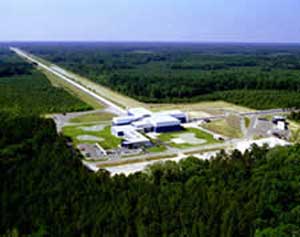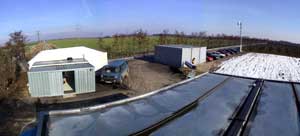Forum on
Education of The American Physical Society
Summer 2005 Newsletter
One of the great challenges the physics community and scientists in general face is informing the general public about the importance of scientific research, both for our future and in our everyday lives. Formal classroom education and informal educational efforts are among the time tested ways to address the challenge. In recent years, however, new ideas have been developed that go beyond simply educating the public. Distributed computing projects allow anyone who owns a personal computer to make a real and vital contribution to scientific research. Such projects often include informal science education components. Perhaps more importantly, people who join the computing efforts are participating in real scientific research and developing increased appreciation for the benefits that science offers. It is with these things in mind that the American Physical Society spearheaded the launch of the world's first physics research-based distributed computing project, Einstein@Home, as one of the cornerstone projects for the World Year of Physics 2005. Einstein@Home relies on donated computational power from private PCs to analyze gravitational wave data for signals emanating from extremely dense, rapidly rotating neutron and quark stars. Einstein's General Theory of Relativity predicts that accelerating massive objects should radiate gravitational waves. New detectors in the US and Europe have now been built to detect those waves. Supernova stars, colliding black holes, and other violent events likely produce the largest gravitational bursts and are good candidates for detectable signals. Rotating quark stars and neutron stars should also emit gravitational waves, if they are not perfectly spherical. Unlike the sudden bursts of violent events, rotating aspherical objects would create continuous gravitational waves, at twice the objects' rotational frequencies. The signal frequencies would gradually decrease as gravitational radiation saps the rotational energy. This phenomenon has already been confirmed circumstantially through the observation of the spin down of binary star pairs. Detecting continuous waves with gravitational observatories, however, presents extraordinary computational challenges. Some known pulsars may emit gravitational signals, but it is likely that most strong sources of continuous gravitational waves are not detectable via conventional astrophysical observation techniques, such as visible, x-ray, or radio astronomy. Ideally, researchers would like to perform whole sky, point-by-point searches for continuous wave sources. The computational demands of this kind of search would be daunting even for the most powerful supercomputers currently in existence. Distributed computing projects have recently been developed to address certain types of computationally intensive problems by tapping into the excess computational power of privately owned PCs. SETI@Home is one of the first and most popular distributed computing efforts. Participants install a screensaver-based program that downloads and analyzes small portions of data collected from the Arecibo radio antenna in Puerto Rico to search for signals indicative of intelligent activity in space. Other distributed computing projects are currently underway to model protein folding (Folding @Home), search for prime numbers (the Great Internet Mersenne Prime Search), and model the Earth's climate (ClimatePrediction.net). The computational capacities of SETI@Home and several other projects currently exceed the power of the world's fastest supercomputer, IBM's BlueGene/L, sometimes by factors of two or three. Typical distributed computing projects achieve their capacities by involving tens to hundreds of thousands of PC owners. Clearly, the potential for large computational capacity and extensive public participation makes distributed computing an ideal tool for scientific research, public outreach, and informal education. In early 2004, the APS World Year of Physics team approached LIGO spokesperson Peter Saulson with a proposal to promote a distributed computing effort for gravitational data analysis as a flagship project in the World Year of Physics 2005 celebration. By mid 2004, Bruce Allen of the University of Wisconsin-Milwaukee was leading an international team of scientists and engineers in writing code and assembling hardware for the project. Primary institutions contributing to the project include the LIGO Scientific Collaboration (LSC), the Albert Einstein Institute in Berlin, the University of Glasgow, the Massachusetts Institute of Technology, and the University of Pennsylvania. Allen and LSC director Barry Barish officially announced the launch of Einstein@Home on February 19, 2005. Einstein@Home, like SETI@Home, is a screensaver-based program. Participants obtain software from the Einstein@Home web page. After they install it, the program downloads several megabytes of gravitational wave data. When a personal computer is idle for a period of time specified by the computer user, the Einstein@Home screensaver is activated and the data analysis algorithm runs. The program automatically uploads the analysis results to one of the Einstein@Home servers and requests more data.
The Einstein@Home screensaver displays a rotating image of the celestial sphere with the major constellations outlined. Red points on the sphere indicate locations of supernova remnants, and purple points indicate known pulsars. Three L-shaped markers represent the directions that the gravitational wave observatories that contribute data to Einstein@Home are pointing: a small red marker represents the 600 meter GEO600 interferometer observatory in Hanover Germany; a green marker represents the 4 km interferometer in Livingston Louisiana; and a blue marker represents the 2 km and 4 km interferometers in Hanford, Washington. A moving, gun sight marker indicates the locations in the sky where the computer is actively searching for gravitational wave signals. Einstein@Home was built on the Berkeley Open Interface for Network Computing (BOINC), a distributed computing framework developed by SETI@Home pioneer David Anderson. The BOINC-based system allows users to contribute to multiple distributed computing projects, in proportions that the user selects. This allows people who currently subscribe to SETI@Home and other projects to dedicate a portion of their computer's time to Einstein@Home as well. In a matter of four months Einstein@Home has become one of the largest and fastest growing distributed computing projects in the world. As of June 1, 2005, over 80,000 people had signed up to participate in Einstein@Home, and nearly 45,000 participants, representing approximately 140 countries, have completed at least some data analysis. The project typically analyses data at a rate of about 80 teraFlops (80 trillion floating point operations per second) or more, significantly outpacing IBM's record-setting BlueGene/L (70 teraFlops). An informal survey indicates that most of the Einstein@Home participants are male scientists and engineers. The APS is currently working to diversify the user base through paid advertising, direct mailing, and media promotion. Articles featuring Einstein@Home have appeared in major newspapers and magazines around the world, and the project has been the subject of numerous radio and television broadcasts. Einstein@Home presents an ideal opportunity for formal and informal education. Message boards on the Einstein@Home web page host lively discussions of physics at levels ranging from elementary introductions to graduate student subjects. Instructors at the Southern University of Baton Rouge reported at the 2005 APS annual meeting in Tampa, Florida that Einstein@Home has helped increase student interest and enrollment in physics classes addressing gravitation and related topics. In Israel, Zvi Paltiel of the Weizmann Institute of Science has organized explanatory material in Hebrew and arranged lectures and workshops encouraging high school students to join Einstein@Home. It is particularly appropriate, as we celebrate the centennial of Albert Einstein's annus mirabilis, that Einstein@Home is helping to search for signs of gravitational waves predicted by Einstein's Theory of General Relativity. Although Einstein did not complete it until 1916, the path to General Relativity began with his work on Special Relativity in 1905. Einstein's miraculous year serves as the inspiration for the World Year of Physics 2005 celebrations, but Einstein@Home will live on after the celebrations conclude. With a little luck, the program will begin to find gravitational sources in coming years. Regardless of the ultimate outcome, the project will continue to grow as a vital scientific, educational, and outreach effort. To learn more about Einstein@Home and join the project, visit the World Year of Physics 2005 home page at www.physics2005.org. James Riordon is the head of media relations for the American Physical Society. He was responsible for the initial conception of Einstein@Home as a World Year of Physics 2005 project. He worked as a freelance science writer for seven years prior to his position at the APS, and began his career as an applications physicist with the short-lived Superconducting Super Collider in Waxahachie, Texas. |



